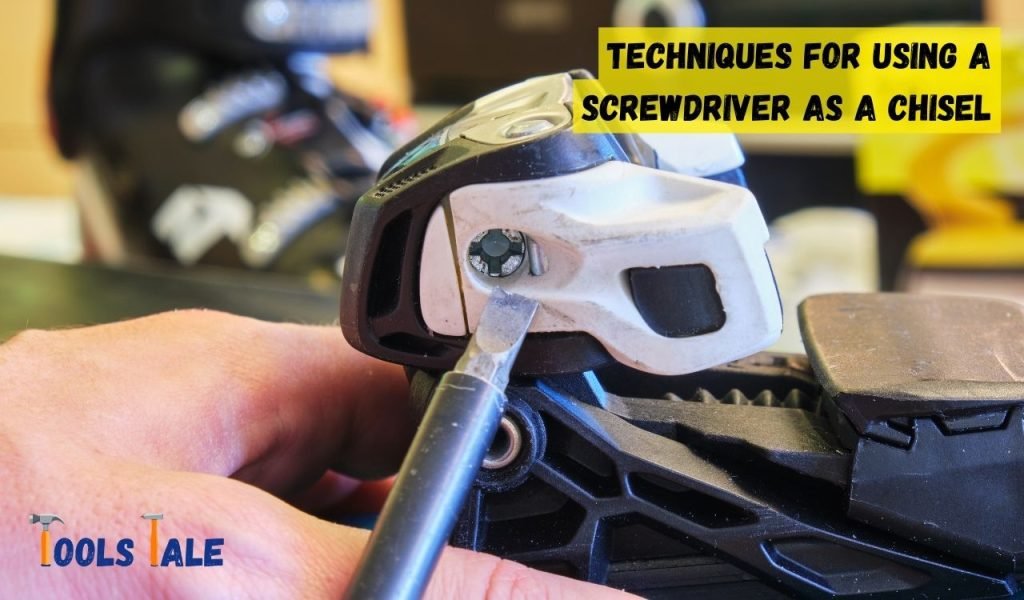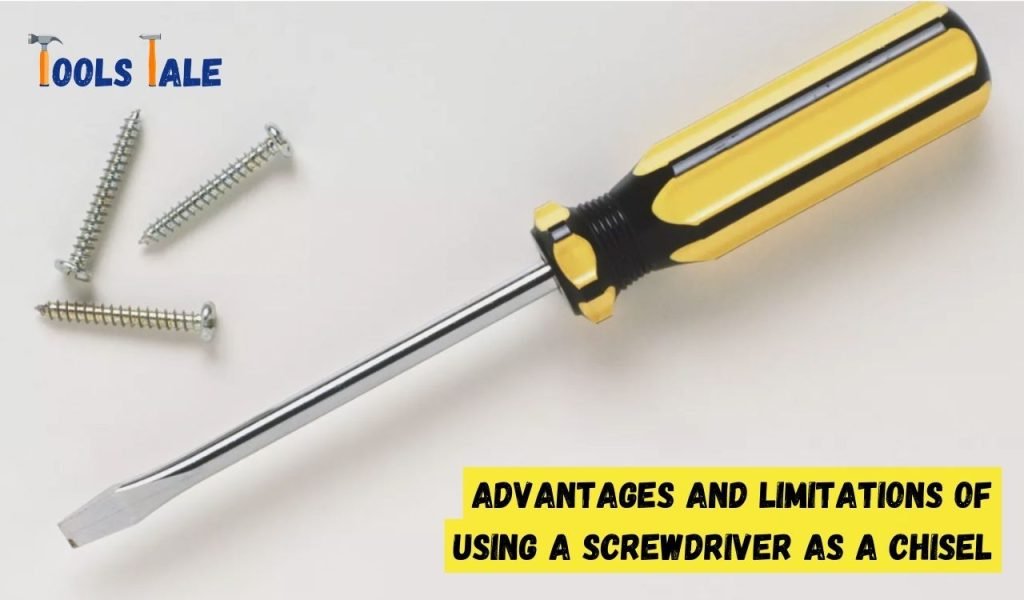Physical Address
304 North Cardinal St.
Dorchester Center, MA 02124
Physical Address
304 North Cardinal St.
Dorchester Center, MA 02124

Wondering about the tool hacks in your DIY arsenal? Ever asked yourself, Which type of screwdriver can be used as a chisel? Well, you’re in for some handy insights! We’re about to dive into the world of tool improvisation, where a humble screwdriver becomes your trusty chisel substitute.
Whether you’re a seasoned DIY enthusiast or just looking to tackle a few home projects, this guide will shed light on how to make the most of what you’ve got. So, if you’re curious about the possibilities of turning that screwdriver into a precision tool for cutting and shaping, let’s explore the tricks of the trade together!
Key Summary: Which Type of Screwdriver Can Be Used as a Chisel?
Screwdriver as chisel: Ideal for light cutting and shaping. Maintain a sharp tip for efficiency. Regular upkeep extends its lifespan. Handle with care, ensuring a firm grip and controlled force. Prioritize safety with protective gear for eyes and hands during use.
The screwdriver, a ubiquitous tool in any toolbox, is primarily designed for turning screws and fasteners. However, in the realm of do-it-yourself projects and woodworking, it can also serve as a makeshift chisel for certain tasks. Understanding the screwdriver-chisel relationship involves recognizing when and how a screwdriver can be repurposed to mimic the actions of a chisel.
A flathead (slotted) screwdriver is often the go-to choice for tasks that require chisel-like actions. Its flat, elongated blade closely resembles a chisel’s edge, making it suitable for light cutting, shaping, or removing material. While a dedicated chisel is designed for precision and depth, a flathead screwdriver offers versatility in a pinch.
When using a screwdriver as a chisel, it’s crucial to consider the task’s nature and magnitude. For light woodworking tasks, such as creating shallow indentations or shaping wood, a flathead screwdriver can be surprisingly effective. It’s advisable to use a screwdriver with a sharp and robust tip to ensure cleaner cuts and precise shaping.
However, it’s important to acknowledge the limitations of using a screwdriver as a chisel. A screwdriver lacks the specialized design and edge quality of a chisel, making it less effective for intricate and detailed work. Additionally, excessive force or inappropriate usage can damage the screwdriver’s tip, rendering it less effective for its original purpose turning screws.
To maximize the screwdriver’s chisel-like capabilities, one should practice proper technique. Maintaining a secure grip on the screwdriver and applying controlled force at the correct angle enhances its performance. Safety precautions, such as wearing safety glasses and using a stable work surface, should always be observed.
While a screwdriver isn’t a direct replacement for a chisel, understanding its potential as a makeshift tool for chisel-like tasks expands its utility in various DIY scenarios. By recognizing when to employ a screwdriver in this alternate role and using it appropriately, one can achieve satisfactory results in tasks that demand a chisel’s functionality. However, for precise woodworking or specialized chiseling tasks, investing in dedicated chisels remains the preferred and more effective choice.
When the need arises to perform tasks that require chisel-like actions but a dedicated chisel is not at hand, repurposing a screwdriver can be a viable solution. However, not all screwdrivers are created equal for such tasks.
Certain types of screwdrivers are more suitable due to their design and structure. Here, we delve into the types of screwdrivers that work best for chisel-like tasks and how to choose the most appropriate one for your needs.
Selecting the appropriate screwdriver for chisel-like tasks involves considering a few critical factors:
Repurposing a screwdriver as a chisel requires careful consideration of its type, tip shape, and the task’s demands. While a dedicated chisel remains the optimal choice for precise woodworking and shaping, understanding the right screwdriver types for chisel-like actions expands your tool repertoire and enables effective solutions in a pinch. Always prioritize safety, technique, and appropriate tool usage to achieve the best results in your projects.

Repurposing a screwdriver as a chisel is a practical skill that can come in handy when you need to perform light cutting or shaping tasks but lack a dedicated chisel. While a screwdriver doesn’t have the same specialized design as a chisel, employing the right techniques can enhance its effectiveness in chisel-like actions. Here, we outline key techniques for using a screwdriver as a chisel to achieve satisfactory results in various DIY projects.
Selecting the appropriate screwdriver for the task is the foundational step. Opt for a flathead (slotted) screwdriver with a sharp, sturdy tip. The screwdriver’s tip should be proportional to the task, ensuring it can make clean cuts and shape the material effectively.
Before using the screwdriver as a chisel, ensure the workpiece is firmly secured to a stable surface. Use clamps or a vice to hold the material securely in place, preventing any unwanted movement during the chiseling process.
Hold the screwdriver at an angle that aligns with the intended cut or shaping action. For cutting, position the screwdriver at a shallow angle to the material’s surface. For shaping, adjust the angle according to the desired contour or depth.
Apply controlled force to the screwdriver by pressing down with your hand or using a mallet. Start with gentle force and gradually increase it based on the material and task. Controlled force ensures precision and prevents potential damage to both the screwdriver and the workpiece.
When cutting or shaping wood or similar materials, work along the grain for smoother results. Chiseling against the grain can cause the material to splinter or break, yielding an uneven finish.
Begin with shallow cuts to familiarize yourself with the screwdriver’s performance as a chisel. Gauge how the screwdriver interacts with the material and adjust your technique accordingly before attempting deeper or more intricate cuts.
To achieve precise cuts or shaping, reposition the screwdriver as needed. Lift it, pivot, or adjust the angle to attain the desired outcome, especially when creating intricate details or shaping curved surfaces.
Maintain a sharp tip on the screwdriver to ensure efficient chiseling. Regularly sharpen the tip using a file or sharpening stone, allowing it to cut through materials with ease and precision.
Like any skill, using a screwdriver as a chisel improves with practice and patience. Start with simple projects, experiment with different materials, and progressively advance to more complex tasks to enhance your proficiency.
Repurposing a screwdriver as a chisel can be a valuable technique in a DIY enthusiast’s toolkit. By following these techniques and practicing them in a safe and controlled manner, you can effectively utilize a screwdriver for chisel-like tasks, achieving satisfactory results in a variety of projects. Always prioritize safety and proper tool usage to ensure a successful and injury-free woodworking or shaping experience.
When repurposing a screwdriver as a chisel for cutting or shaping tasks, safety should be the foremost concern. While a screwdriver can mimic a chisel’s actions, it lacks the specialized design, making adherence to safety precautions crucial. Here are essential safety measures to follow:
Adhering to these safety precautions ensures a safer chiseling experience when using a screwdriver in place of a chisel. Prioritize safety at all times and exercise caution and mindfulness while working with tools to mitigate any potential risks.

Repurposing a screwdriver as a chisel can be a convenient solution when a dedicated chisel is unavailable. However, this makeshift approach has its own set of advantages and limitations that should be considered before employing it for chiseling-like tasks.
Using a screwdriver as a chisel offers versatility and convenience, making it suitable for simple cutting or shaping tasks when a dedicated chisel is not available. However, it’s essential to recognize its limitations, particularly in achieving precision and controlling depth. Assess the specific task at hand and weigh the advantages and limitations before deciding whether repurposing a screwdriver as a chisel is the most suitable approach.
Repurposing a screwdriver as a chisel is a useful workaround, but it’s crucial to maintain and care for the screwdriver to ensure its longevity and optimal performance. Here are essential tips to help you extend the lifespan of your screwdrivers when used as chisels:
By following these tips and maintaining your screwdrivers effectively, you can significantly extend their lifespan and enhance their performance as makeshift chisels. Proper care and attention to maintenance will ensure that your tools remain reliable and functional for a longer period.
While a screwdriver can be improvised as a chisel for light cutting and shaping tasks, it’s important to acknowledge its limitations. The flathead screwdriver, especially, resembles a chisel but lacks the precision and specialized design. For occasional and minor woodworking needs, this makeshift approach can suffice.
However, investing in proper chisels remains the superior choice for accurate and intricate work, ensuring optimal results and a more efficient woodworking experience.
Yes, a screwdriver can be repurposed as a makeshift chisel for light cutting and shaping tasks in woodworking. However, it’s important to note that a screwdriver is not designed to perform with the precision and efficiency of a dedicated chisel. It is best suited for simple tasks where a chisel-like action is needed but fine detail or accuracy is not critical.
Certainly, a flat head screwdriver is commonly used as a makeshift chisel. Its flat blade resembles a chisel’s edge, making it suitable for tasks that require shallow cuts or gentle shaping. It can be effective for basic woodworking needs when a dedicated chisel is not readily available.
While flat head screwdrivers can mimic chisel-like actions, there are no screwdrivers specifically designed for chiseling. For precision and efficiency, dedicated chisels are the recommended choice.
While flat head screwdrivers are often used as makeshift chisels, not all screwdrivers are suitable. Choose a flat head screwdriver for shallow cuts and shaping, but dedicated chisels are optimal for precision.
Select a flat head screwdriver with a sharp, sturdy tip and a width appropriate for the task. Ensure it can handle the material and task requirements effectively for a makeshift chisel.
Using a screwdriver as a chisel for metalworking is generally not recommended. Metalworking chisels are designed with the specific requirements and durability needed for working with metal materials. Attempting to use a screwdriver for metalworking tasks may lead to inefficiency, potential damage to the tool, and unsatisfactory results. It’s advisable to use the appropriate metalworking chisels for such projects.